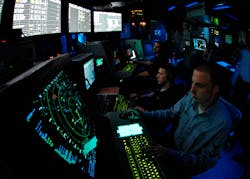Air Force researchers eye ways to enable autonomous unmanned aircraft operations in controlled airspace
WRIGHT-PATTERSON AFB, Ohio – U.S. Air Force researchers are asking industry for technologies to enable unmanned aircraft to operate autonomously in congested airport terminal areas while following the same air traffic control (ATC) procedures as crewed aircraft.
Officials of the Air Force Research Laboratory at Wright-Patterson Air Force Base, Ohio, issued a request for information (RFI-RQKHC-2022-0001) on Tuesday for the Terminal Area Operations: Unmanned Aerial Systems project.
Researchers are trying to find companies able to provide enabling technologies for uncrewed aircraft to start, taxi, take off, depart, join aircraft formations, approach, land, taxi, and shut down within controlled airspace at cruise altitudes, in terminal airspace, and at large- and medium-sized airports.
This airspace is in the contiguous United States within the National Airspace System (NAS), as well in international airspace outside the U.S. Technologies developed are expected to be foundational for fully autonomous unmanned aircraft operations.
Related: Artificial intelligence and machine learning for unmanned vehicles
This request for information is to help government, academia, and industry understand the state of the possible that can deliver the autonomous technologies for unmanned aircraft operation in the terminal area, researchers say.
Unmanned aircraft today require much pilot-in-the-loop interaction in airport terminal areas -- much the same as piloted aircraft in the terminal area must follow established U.S. Federal Aviation Administration (FAA) and International Civil Aviation Organization (ICAO) standards and procedures.
The goal is for unmanned aircraft to comply with the same standards and procedures as well as with those unique to unmanned aircraft, autonomously with minimal pilot and ground controller interaction.
Automating some or all of these procedures could help reduce human operator workload and oversight necessary for operating unmanned aircraft in the terminal area.
The main goal, first, is to identify technologies suitable for integration and flight testing an autonomous terminal area operations functionality in an unmanned aircraft using existing airspace, airfield, and ATC infrastructure.
Solutions will be able to team humans and machines, and be able to scale-up to several different unmanned aircraft safely and in compliance with FAA and ICAO standards and procedures.
Air Force researchers say they plan to demonstrate autonomous capabilities that would enable unmanned aircraft to operate as though they were piloted aircraft. Once clearance is given, unmanned aircraft would start, taxi, take off, rejoin, switch to enroute flight, arrive at a destination, fly an approach to a runway, land, taxi, and shut down while autonomously avoiding conflicts on the ground and in the air.
Unmanned aircraft would maintain communication with ATC, airport ground control, and several unmanned aircraft with a backup capability in the event of loss or misunderstood communications. Navigation and runway approach with and without GPS also is required.
Related: Wisk prepares to launch trial to advance autonomous passenger transport
From industry, Air Force researchers want to know:
-- what level of in-aircraft automation is available today, and what technology gaps exist;
-- what technologies exist that would enable a unmanned aircraft to navigate autonomously on the ground and in the air while deconflicting from other obstacles and other aircraft;
-- what technologies exist that would enable ATC control of unmanned aircraft in a similar fashion as manned aircraft with the same level of reliability;
-- what technologies exist that would enable an unmanned aircraft to receive, process, and respond to ATC commands;
-- could controller pilot data link communications (CPDLC) reliably receive ATC messaging for unmanned aircraft control;
-- what other means can be used to receive ATC messaging reliably;
-- what kinds of sensors are necessary to enable autonomous aircraft operation in the terminal area;
Related: Enabling technologies for urban air mobility
-- can ADS-B provide deconfliction for ground and air traffic from startup through airborne operations to shutdown;
-- what are the challenges and capabilities for extending such technologies to accommodate several unmanned aircraft being controlled and overseen by one operator, and how do these technologies scale as the number of unmanned aircraft increase;
-- what safety concerns must be considered, and how would contingencies be handled;
-- what technical or procedural limitations exist to extend these capabilities for military training and operations outside U.S. airspace; and
-- what command, control, and navigation systems are certified for use in the NAS by a unmanned aircraft, and what is the path forward for certification.
Companies interested should email 20-page white papers no later than 23 June 2022 to the Air Force's Capt. Christian Potts at [email protected], with a copy and supporting documentation on CD or DVD sent by post or by courier to Capt. Christian Potts, 2210 8th St., Wright-Patterson AFB OH 45433.
More information is online at https://sam.gov/opp/a74f0b2cb8be40c8b82a2c9618c54c71/view.

John Keller | Editor-in-Chief
John Keller is the Editor-in-Chief, Military & Aerospace Electronics Magazine--provides extensive coverage and analysis of enabling electronics and optoelectronic technologies in military, space and commercial aviation applications. John has been a member of the Military & Aerospace Electronics staff since 1989 and chief editor since 1995.

